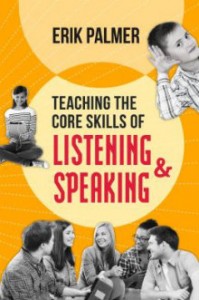Listening and Speaking: Essential Skills
Teaching the Core Skills of Listening and Speaking
By Erik Palmer
(ASCD, 2014 – Learn more)

Erik Palmer makes a compelling case for the explicit instruction of communication skills in his book Teaching the Core Skills of Listening and Speaking. In the beginning, he rightly points out that these skills are the MOST important beyond the classroom – you won’t find any job that doesn’t include them – and yet they are some of the most overlooked.
Teachers continually expect that requiring a lot of speaking and listening equates to learning to be good speakers and listeners – which it does not. As I read, I found myself critiquing my own teaching. I reflected on the terrible, mind numbing presentations by students I have been witness to and then came to the awful conclusion that it was not their poor presentation skills that were to blame but my 
Palmer, a long-time advocate of improving oral communication skills in our students, not only does a great job of making clear why we need to change the way we teach our students to communicate but also lays out a clear design for how to make it happen in a purposeful way in any classroom.
Significance beyond the Common Core
After his introduction Palmer makes clear that, although there is new attention being paid to speaking and listening because of the Common Core State Standards, that is not why we should be teaching speaking and listening or why they are important. He is aware that the focus of education is always changing but stresses that listening and speaking skills are more important than ever with video conferencing, webinars, podcasts, and online videos being integral parts of the workplace and workplace training.
That will continue to be true, regardless of our educational climate. The Common Core tells us something about where to go with our students and where they should have been, but Palmer’s book does what the standards do not: it tells us, as teachers, how to get there.
Delineating the CCSS
Teaching the Core Skills of Listening and Speaking breaks Speaking and Listening Standards into two main sections. Palmer calls the first three anchor standards (the Collaboration and Communication standards) the “listening standards,” and the next three (the Presentation of Knowledge and Ideas standards) the “speaking standards.”
He then devotes a chapter to each standard, first detailing how the standard evolves from grade to grade and giving the implications at each level. He then explains what each element is and, what’s more, what it isn’t (even if that is how it has customarily been done in the classroom). He provides sub-sections in each chapter to make sure teachers understand each element — what makes discussion collaborative, content, delivery, presentation etc. — prior to giving ideas for how to “Take Action” in developing skills in our students.
Palmer’s approach is very helpful in understanding exactly how to assist students to become better communicators.
Classroom practice, lessons included
I appreciated the many examples of how these skill building lessons and tasks could be done in various grade levels and subject areas. Palmer points out that all teachers are responsible for teaching these skills. He also pays a great deal of attention to the importance of 21st century skills and why they need to be included in our classrooms.
Many teachers may not have 21st century media competency, although we are supposed to be teaching using current technologies. Palmer offers the idea that students show teachers the tools they use, and we help them to use them more efficiently for the task at hand.
I liked that Palmer wasn’t tied to the standard, repeatedly making the case that these skills are imperative with or without the CCSS. In fact, in the section on standard 4, which Palmer thinks doesn’t go far enough in its expectations (focusing more on content than delivery), he gives ideas for teaching skills and evaluating them through performance.
A little light on assessment
The final chapter on assessment was the only element of the book with which I was somewhat dissatisfied. Palmer gives an overview of how the SBAC and PARRC evaluate the standards in their assessments, and of how teachers shouldn’t assess content over delivery, even providing some ideas on rubric do’s and don’ts. But he doesn’t do enough to explain exactly how to assess incidental listening and speaking, like class and individual discussions, in real classroom environments.
On the other hand, he gives credence to the idea that in the end teachers can use their judgment in measuring the growth of our students’ listening and speaking skills to show that they are making gains, which I appreciated.
Teaching the Core Skills of Listening and Speaking clearly articulates that the question is not should we be purposefully and explicitly teaching speaking and listening skills but how can we continue to ignore their importance any longer in our increasingly digital age? And then the book shows us how teaching these skills can be done without sacrificing other content.
Rebecca Crockett currently teaches middle school language arts in north central Idaho, where she lives with her husband and two young children. She is in her eighth year of teaching. She is also part of the Idaho Core Teacher Leader Program involved in developing and reviewing units, lessons and assessments that align with the Common Core State Standards and in providing professional development in instructional practices and CCSS implementation.



































Thank you for advancing the work!! We are talking about the most important language arts here, and we need everyone on the bandwagon. Your review will certainly contribute to making that happen. And thank you for giving me a new direction to pursue, evaluating incidental speaking. Insightful comment, and I will work to address it.
This was a great article that helped me really think about communication skills training for employees! Thanks so much for sharing this information. It’s so hard not to critique your own teaching when you read great books like this, and it sounds like I need to check my library for “Teaching the Core Skills of Listening and Speaking” next time I’m there.
No matter what you’re doing, every job requires you to excel at listening and speaking, but you cannot simply include a lot of this in your training and expect the job to be done. In fact, I’ve known employees who didn’t feel that their employer included either subject in their training, and more shockingly, they didn’t think that they needed to improve their listening and speaking skills.
Thanks for outlining the introduction and subsequent sections of Erik Palmer’s book, it helped me see that it would probably be of great use for me. As a remote worker and tech-obsessed millennial, I loved that it touches on video conferencing, podcasts, online videos, and webinars. I don’t need to tell anyone who lived through 2020 how much more important all of this is today, and I think it will only keep getting more crucial to success. Thanks again for this post. It got me thinking and examining my own habits!